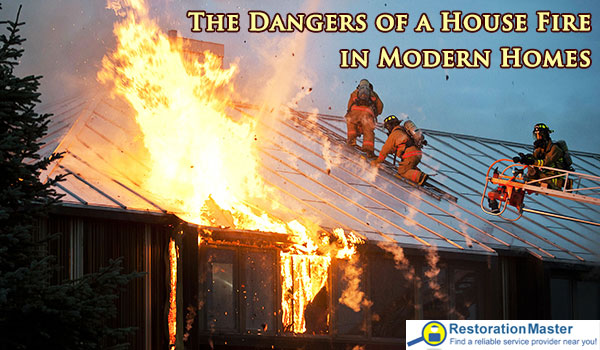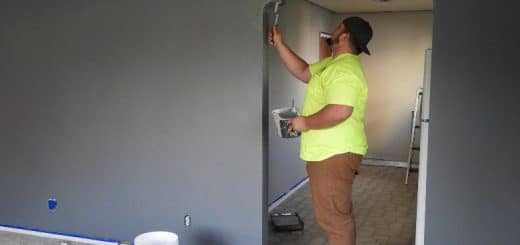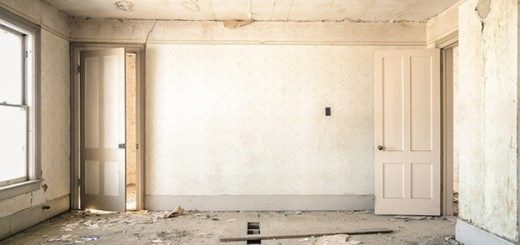How to Prevent Slips, Trips, and Falls in the Home
Nothing is more frightening than an unexpected fall. It can be both physically and emotionally painful, leaving you with minor or even major injuries that could have been prevented with the right measures in place.
According to the Centers for Disease Control and PreventionPrevention refers to actions taken to reduce the likelihood ... More, over one million Americans experience a slip, trip or fall injury annually. These incidents are so prevalent that the National Safety Council has dedicated the second week of June—National Safety Month—to preventing slips, trips, and falls. Knowing how to protect yourself from accidents should be top priority in any home safety plan. In this blog post we will explore practical tips for preventing personal injury due to slipping, tripping, or falling in your own house or apartment.
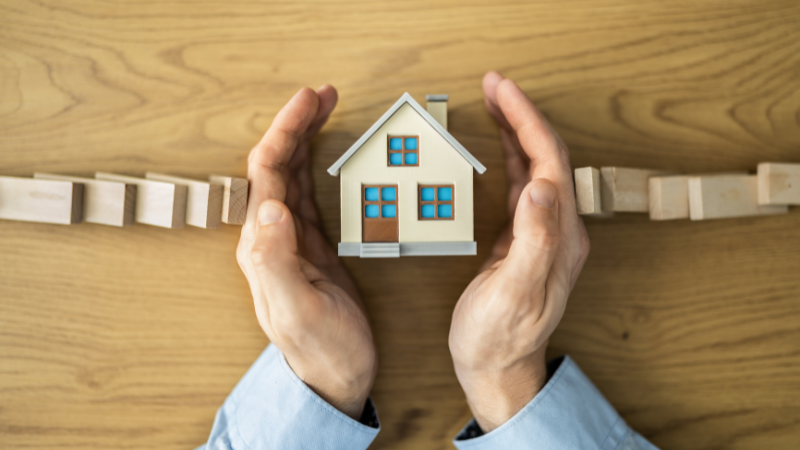
Identifying Potential Hazards
Floors and Surfaces
Types of flooring that cause trips are a serious concern in our homes, offices, and public spaces. Loose rugs, carpet, and mats can easily become potential tripping hazards, especially when they are placed on hard floors or in high traffic areas. Cluttered walkways and obstructed paths can also be a real challenge, especially in spaces where there is a lot of activity or limited floor space. Because of this, it’s important to be aware of the types of flooring that can potentially cause tripping and take preventive measures to ensure that your floors are as safe and slip-resistant as possible.
Stairs and Steps
There are also major safety hazards associated with uneven or broken steps, lack of handrails, and inadequate lighting. These conditions can pose a serious risk of slips, trips, and falls in homes, and put the occupants of the house at risk of potential injury. Whether caused by age or wear and tear, uneven or broken steps can catch someone off guard and leadLead is a heavy metal that can be toxic to humans, especiall... More to a painful fall. Properly installed handrails are essential, particularly in homes where elderly residents, those with disabilities or young children are present. Adequate lighting is also crucial to ensure that all potential hazards are visible.
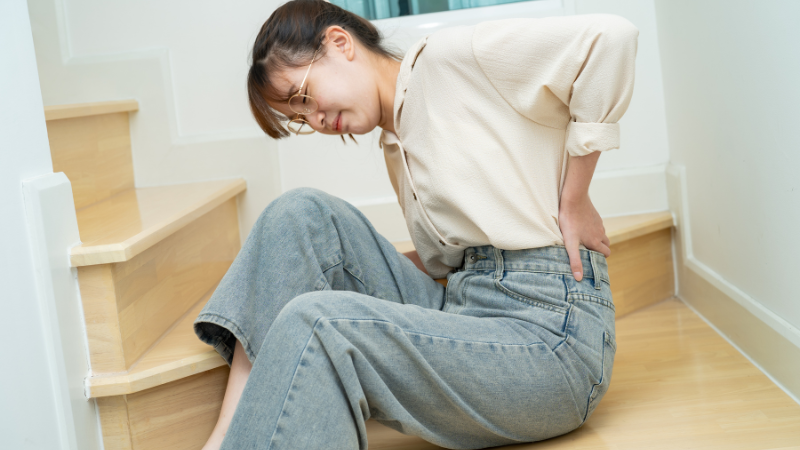
Bathrooms and Wet Areas
Slips, trips, and falls are common accidents that can happen to anyone, anywhere. However, they are more prevalent in situations when floors and surfaces are slippery or wet, or when there are no grab bars, non-slip bathmats, or other safety fixtures that would prevent these mishaps. These sorts of accidents, while often minor, can also result in serious injury, especially for the elderly or people with disabilities. By paying attention to your surroundings and implementing safety features in your bathrooms and other wet areas in your home, you can work to prevent these incidents from occurring.
Tips for Preventing Slips, Trips, and Falls
General Home Maintenance
Creating a safe environment at home is crucial to avoid accidents like slips, trips, and falls. Here are some simple yet effective strategies to ensure safety:
- Maintain Clean and Dry Floors: Wet or dirty floors can be a major hazard. Make sure to clean up any spills promptly and keep floors dry. Regular cleaning can also prevent the build-up of dust or grime that could potentially make surfaces slippery.
- RepairRepair is the act of fixing or restoring damaged property, m... More or Replace Damaged Flooring: Cracked tiles, frayed carpets, or uneven floorboards can easily cause someone to trip. It’s important to repairRepair is the act of fixing or restoring damaged property, m... More or replace damaged flooring as soon as it’s noticed to maintain a safe walking surface.
- Declutter Your Space: Clutter and obstacles in walkways or hallways can pose a tripping hazard. Make sure to keep these areas free from unnecessary items. Regularly organizing and decluttering your home can help maintain clear paths and prevent accidents.
Stairs and Steps Safety
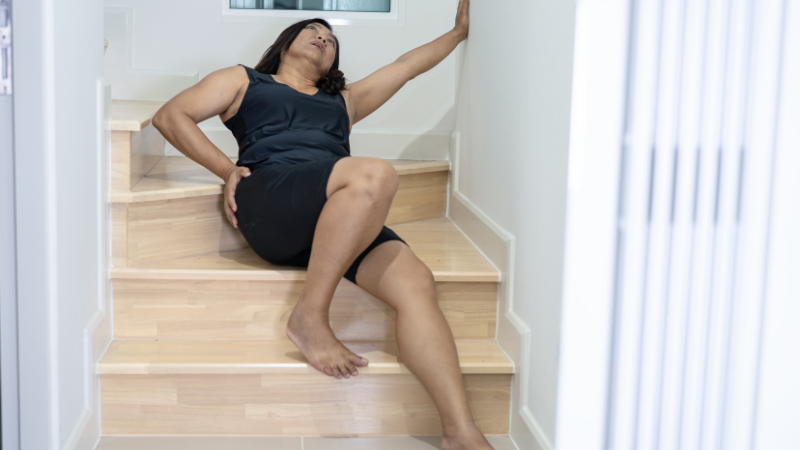
Preventing Slips, Trips, and Falls at Home: Additional Measures
While maintaining clean floors and removing clutter are fundamental steps towards a safer home, there are more measures you can take to prevent accidents. Here are some additional strategies:
- Handrail Installation: Handrails on both sides of the stairs provide extra support and balance, significantly reducing the risk of falling while ascending or descending the stairs. This is particularly helpful for individuals who may need additional assistance, such as the elderly or disabled.
- Proper Lighting: Adequate lighting is crucial for spotting potential hazards around the house. Ensure all areas, including stairs, hallways, and rooms, are well-lit. Consider installing nightlights in frequently used areas during the evening and early morning hours.
- Non-Slip Treads or Adhesive Strips: Applying these to your stairs and other potentially slippery surfaces can provide extra grip and significantly reduce the chance of slips and falls. They are especially useful in wet-prone areas like bathrooms and kitchens.
Bathroom Safety
To further enhance safety in your home and prevent accidents, consider these bathroom safety tips:
- Use Non-Slip Mats or Adhesive Decals in Showers and Tubs: These can provide extra grip in wet areas and significantly reduce the risk of slipping while showering or getting in and out of the tub.
- Install Grab Bars Near Toilets and Shower Areas: Grab bars offer support and stability in areas where balance is critical. Installing them near toilets and showers can help prevent falls, especially for those who may have difficulty with mobility.
- Maintain Dry Floors and Use Bathmats for Extra Traction: Wet floors are a common cause of slips and falls. Keep floors dry, particularly in bathrooms and kitchens, by promptly cleaning up any spills. Using bathmats can provide additional traction and absorb excess water.
Making the Home Safe for Older Adults
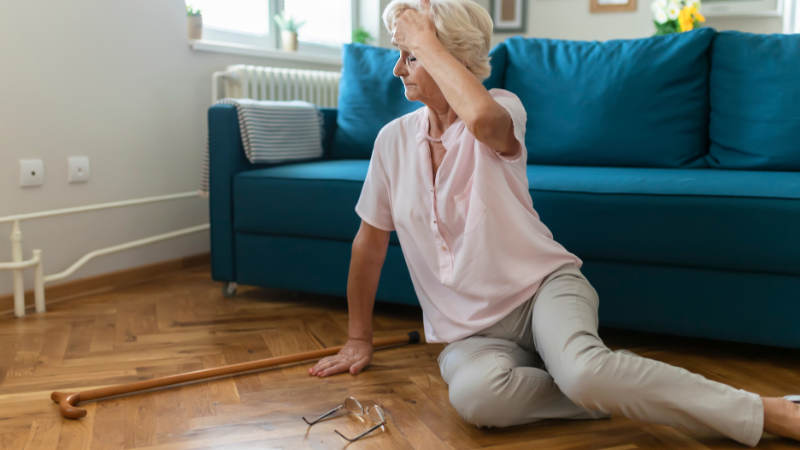
Age Related Risk Factors
As we age, the risk of slips, trips, and falls increases. Studies have shown that falls are the leading cause of both fatal and non-fatal injuries for adults 65 and older. There are a variety of factors that can contribute to this risk, including decreased muscle strength, decreased balance and coordination, changes in vision, and the use of certain medications. However, it’s important to note that falls are not an inevitable part of aging. Through simple preventative measures like the ones we’ll discuss below, seniors can reduce their risk of falls and ensure their safety. It’s never too late to take steps towards fall preventionPrevention refers to actions taken to reduce the likelihood ... More and maintain independence and quality of life in older age.
Additional Considerations for Elderly Individuals
As we age, our risk of experiencing a fall increases. However, there are several strategies that can help to significantly reduce this risk for elderly individuals
- Adequate Lighting Throughout the Home: Good lighting is crucial in preventing falls. Ensure all areas of the home, especially hallways, stairs, and bathrooms, are well-lit. Consider installing nightlights in areas that are frequently used during the evening or early morning hours.
- Use of Assistive Devices and Mobility Aids: Devices such as canes, walkers, or wheelchairs can provide additional support and balance, reducing the risk of falls. It’s important that these aids are correctly fitted to the individual to ensure their effectiveness.
- Regular Exercise and Physical Therapy: Regular physical activity can improve strength, balance, coordination, and flexibility, all of which can help prevent falls. Physical therapy might also be beneficial for those who have already experienced a fall or who have mobility issues.
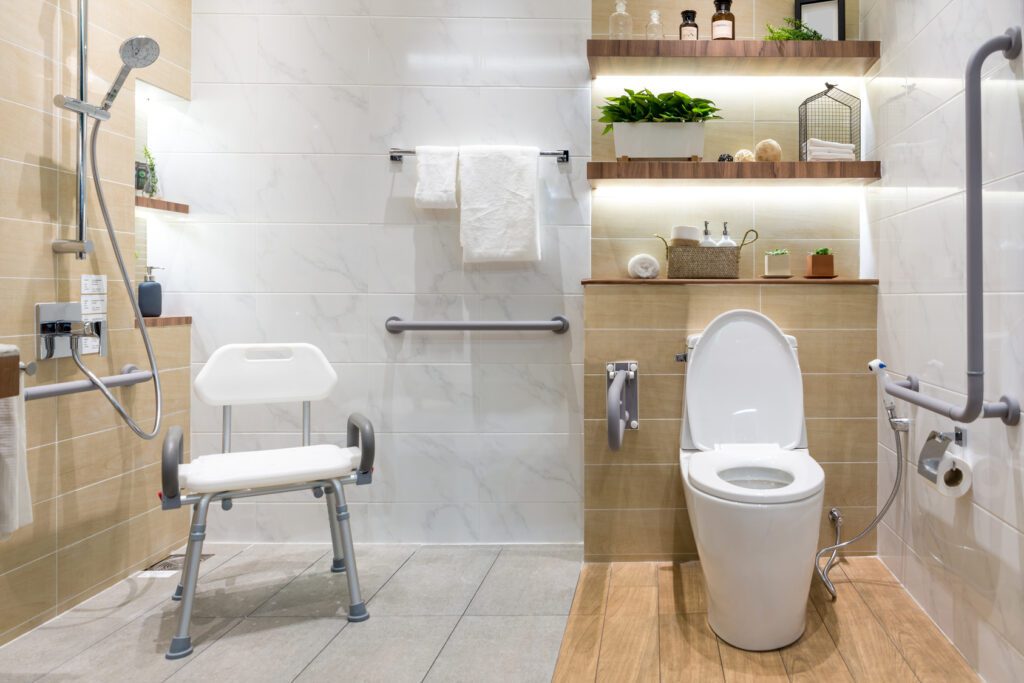
Interior of bathroom for the disabled or elderly people
Home Modifications for Advanced Safety
As our loved ones age, it’s crucial to adapt their living environment to their changing needs. Here are some home modifications that can significantly reduce the risk of slips, trips, and falls in the elderly:
- Installing Handrails and Grab Bars: Handrails on both sides of stairs and grab bars in bathrooms provide additional support and stability. These safety features can be particularly helpful when balance may be compromised due to age or health conditions.
- Removing Trip Hazards and Improving Lighting: Clear walkways of clutter and potential trip hazards such as loose rugs or cords. Additionally, ensure all areas of the home are well-lit. Consider installing extra lighting in darker areas and nightlights for safe navigation during the evening or early morning hours.
- Considering Assistive Technologies: There are numerous assistive technologies designed to increase safety for the elderly at home. Devices such as medical alert systems can provide peace of mind by ensuring help is readily available in case of a fall.
By implementing these home modifications, you can create a safer living environment for elderly individuals, reducing the likelihood of accidents and enhancing their independence and quality of life.
Promoting a Safety Culture at Home
Creating a safe environment at home goes beyond physical modifications; it also involves fostering a culture of safety among your family and your guests to prevent accidents. Here are some ways you can promote this culture within your home:
- Educating Family Members and Caregivers: Everyone living in or visiting the home should be aware of the measures in place to prevent slips, trips, and falls. This includes understanding the purpose and correct use of safety features like handrails, grab bars, and non-slip mats.
- Encouraging Open Communication: Your family and visitors should feel comfortable discussing potential hazards or safety concerns. Regular discussions about safety can help everyone stay vigilant and proactive in maintaining a safe environment.
- Regular Safety Assessments and MaintenanceMaintenance is the routine care, inspection, and repair of a... More Checks: Regularly inspect your home for potential hazards such as loose rugs, cluttered walkways, or poor lighting. Also, ensure that safety features like handrails and grab bars are securely fastened and in good condition.
- Creating an Emergency Plan: Despite all precautions, accidents can still occur. An emergency plan ensures everyone knows what to do in case of a fall, including who to contact and where first aid supplies are located.
Conclusion
Taking the initiative to ensure home safety is an important and necessary step in protecting yourself, your family, and your loved ones from slips, trips, and falls. The National Safety Council is doing its part this June by dedicating the second week to raising awareness for these types of hazards. By being mindful of the potential risks posed by floors and surfaces, stairs and steps, bathrooms, and wet areas—as well as age related risk factors—we can take measures to avoid them altogether. Simple home maintenanceMaintenance is the routine care, inspection, and repair of a... More such as keeping the floor clean and dry, making repairs or replacements when needed, or installing handrails are essential safety precautions that anyone can take. For older adults, more advanced adjustments such as assistive devices or improved lighting may be necessary. Ultimately it is important to remember that an investment in home safety today is a safeguard for both present and future health.
Keeping your carpet clean is one way to contribute to a safer home. Dirt, dust, and other debris accumulate within carpeting and if it is not removed, it can affect the appearance of the carpet and cause damage to the fibers. The debris may also impact the air quality of your home. When you call a professional for carpet cleaning, you can expect them to fully remove all dirt, debris, and stains from your carpet and restore its original appearance.










